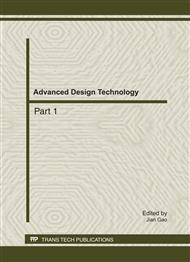p.882
p.886
p.890
p.894
p.899
p.908
p.914
p.918
p.923
The Optimal Research of Force Increasing Mechanism of Injection Machine
Abstract:
The analysis of motion and mechanics property was carried out on the five hinged incline arranged and double elbowed force increasing mechanism of injection machine. A complete optimization designing procedure was carried out by improved ant colony algorithms, so as to increase the stroke ratio and the amplification of the force, and to decrease the total length of mechanism. Its optional mathematics model was established. The procedure of optimal design belongs to multi-object optimal problem. The optimal solution of the force increasing mechanism was found with improved ant colony algorithms. Compared with the traditional methods, the result shows that the total length of mechanism is decreased, the stroke ratio is increased, and the amplification of the force is increased. Furthermore, a sensitivity analysis of various design parameters has been performed to observe changes in injection performance parameters, and results show that the length of back elbowed bar and the length of connected bar have a significant impact on the performance measures. And the results recommend that the close clearance of the length of back elbowed bar and the length of connected bar must be maintained. Therefore it can provide some valuable instruction and theory to engineers. The instance of 1000 N large-scale injection molding machine is taken as an example to demonstrated that such method is effective and practical.
Info:
Periodical:
Pages:
899-907
Citation:
Online since:
August 2011
Authors:
Price:
Сopyright:
© 2011 Trans Tech Publications Ltd. All Rights Reserved
Share:
Citation:


